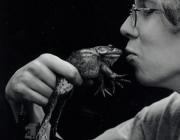Survival, song and sexual selection in the fall field cricket
There is a debate within evolutionary biology that goes back as far as Wallace and Darwin, as to whether sexual ornaments and survival covary positively or trade off with each other. As part of my PhD thesis, I and two colleagues investigated the condition-dependence of sexual display (calling effort) and survival in the fall field cricket, Gryllus pennsylvanicus. Our results show that high-condition males invest more in both calling effort and survival than low-condition males, and that there is a positive correlation between the two life history traits (Wallace’s view). However, recent research on an Australian field cricket (Hunt et al. 2004, Nature 432:1024) is the first empirical evidence of Darwin’s proposal that males can invest in sexual display to the detriment of their own survival. In our paper we contrast the two studies and propose that differences in the ecology of the two species play a large role in shaping their strategies of resource allocation to important life history traits.
Other projects include: 1) a bioacoustic analysis of G. pennsylvanicus song to look for parameters that reveal a male’s age, 2) testing the condition dependence of female preference for high effort song, and 3) an experiment showing that female social experience affects the shape of sexual selection on males. Collaborators: Darryl Gwynne (University of Toronto Mississauga) and Janice Ting (now at University of Toronto)
Linking microevolution to macroevolution: measuring selection within a phylogenetic context
One of the great questions in biology is whether the diversity of the tree of life is governed by historically contingent processes like genetic drift or Darwinian selection. We (see Collaborators below) are measuring the shape and direction of sexual selection simultaneously for a group of related insects to test the hypothesis that the current pattern of selection across the clade was responsible for the observed pattern of evolutionary divergence. We are using hump-winged grigs (Orthoptera, Haglidae, Cyphoderris) for this research because it is relatively easy to assay individual males’ fitness in the wild. Copulating female Cyphoderris chew on the male’s fleshy hind wings, damaging them permanently. This damage is costly to males although not fatal, and median male lifetime mating success is one mating, ensuring that there is sufficient variability in male fitness to detect selection. Furthermore, there are only three known species in the genus (C. buckelli, C. monstrosa, C. strepitans) for which a phylogeny has recently been published.
Collaborators: Paul De Luca and Andrew Mason (University of Toronto Scarborough), Glenn Morris (University of Toronto Mississauga), Geoff Ower and Scott Sakaluk (Illinois State University)
The evolution of aggression and weaponry in field crickets
Field crickets (Orthoptera, Gryllidae, Gryllinae) are well known as highly aggressive animals, and have been used as model organisms for both the scientific study of aggressive behaviour and blood sport in China since at least the Sung Dynasty. Male field crickets have larger heads and biting mouthparts than females, and use these weapons to grapple with other males for the possession of territories from which they sing and attract females. We found that weaponry in male field crickets (large heads and mouthparts) is sexually selected through aggressive physical combat. In so doing, we scientifically validated the millennium-old Chinese cultural practice of betting favourably on big-headed male crickets during sporting cricket fights. In addition to this broad cultural interest, our results bear on previous comparative research and suggest that the evolution of larger weaponry in crickets is associated with more costly fighting behaviour.
Collaborator: Vanessa Bonanno
Geographic and temporal variation in sexual selection in bullfrogs
The extent to which sexual selection varies in time and space continues to be a major question for evolutionary biologists. Bullfrogs, Rana catesbeiana, have been a model system for the study of breeding systems in the wild, and a number of populations have been studied over multiple years. I am collaborating with a number of other researchers to compile estimates of male bullfrog mating success for multiple populations and years to assess the variability of sexual selection on males.
Collaborators: Ron Brooks (University of Guelph), Susan Herrick and Kent Wells (University of Connecticut)Aggression in Madagascar hissing cockroach
Animal conflict is ubiquitous, and questions regarding the evolution of aggressive behaviour and the mechanisms of contest settlement are lively areas of research. Previous research in the Cade lab has shown that male Madagascar hissing cockroaches, Gromphadorhina portentosa, display repeatable individual differences in their tendency to be aggressive with other males. I am interested in whether this aggressiveness covaries with the rather prominent pronotal horns that males use in physical combat. Collaborators: Bill Cade (University of Lethbridge), David Logue (University of Puerto Rico)
Population differences in body shape in Mormon crickets, Anabrus simplex
Study systems in which the typical sex roles are reversed (i.e. competitive females and choosy males) offer unique opportunities to examine the evolution of sexual phenotypes. Mormon crickets, Anabrus simplex, provide just such a system in that there is population level variation in the extent of sexual selection on males and females. Some populations live in high densities and march across the landscape in large bands which are characterized by female competition for male derived mating meals. Whereas other populations exist at low densities, do not march, and where males and females display typical sex roles. We are testing the hypothesis that differences in sexual selection between these two population types have resulted in morphological adaptations as well as differences in the extent of sexual dimorphism.
Collaborators: Darryl Gwynne (University of Toronto Mississauga), Pat Lorch and Stacey Neal (Kent State University)


